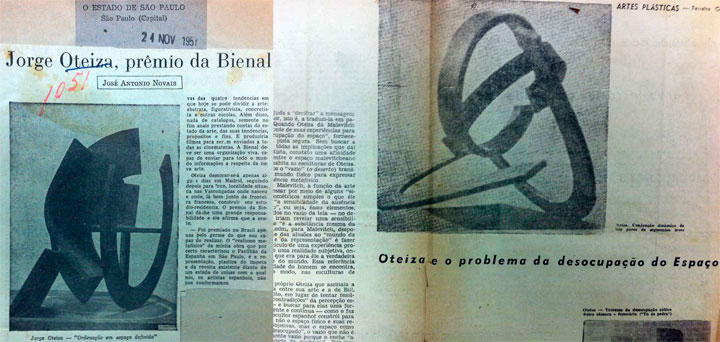
Asier Mendizabal working on the installation of his work. 25/08/2014. ©Pedro Ivo Trasferetti / Fundação Bienal de São Paulo.
‘The work [Spanish artist] Asier Mendizabal produced for the 31st Bienal critically reinscribes within a contemporary art context the sculptural praxis of [his fellow countryman] Jorge Oteiza (1908-2003), whose involvement with Latin America between the 1930s and 1960s was influential yet largely overlooked.’ (31st Bienal Guide, p.36)

Jorge Oteiza with his sculpture Empty Spiral Expansion at the 4th (1957) – Image from the website Museu Guggenheim Bilbao.
In fact, the artist Jorge Oteiza established a strong connection with Brazil after the 4th Bienal de São Paulo, in 1957, at which he won the Grand Prize for Sculpture. According to Leonor Amarante, in her book As Bienais de São Paulo / 1951 a 1987, the choice of Oteiza, ‘a relative unknown’, was the big surprise that year, as the runaway favorite was the English sculptor Lynn Chadwick.
It should be remembered that the 4th Bienal was one of the most turbulent editions of the event, which had recently experienced exponential growth and achieved legitimacy as the leading art-world showcase in Latin America. The controversy began with the selection of works for the exhibition, made by a rigorous jury panel that left out submissions by the likes of Maria Bonomi, Darcy Penteado, Felícia Leirner, Aldo Bonadei, Flávio de Carvalho, who, in reprisal, demanded the cancellation of the show, while Bonadei threatened to burn his rejected works. That year the Bienal moved into the pavilion, the former Palace of Industries, built to house industrial expos during the 4th Centennial of São Paulo celebrations.

Jorge Oteiza – standing beneath the plaque “Artistas Laureados” – at the 4th Bienal Prize-giving Ceremony, alongside fellow award-winners Franz Weissmann, Fernando Lemos, Fayga Ostrower, Frans Krajcberg. Photographer unknown.
Despite the controversy, the little-known artist Oteiza was widely acclaimed by various leading critics of the day. In the artist’s dossier in the Archive we found clippings from numerous newspapers discussing the artist and his work. In Jornal do Brasil on October 27, 1957, the young Ferreira Gullar wrote:
‘One could say that the Grand Prize for a Foreign Sculptor—as was the case with Max Bill at the first edition of the Bienal—practically introduced a new name to the international art milieu—that of the Spanish sculptor Oteiza.’ Further on in the same text Gullar says that ‘It is Oteiza himself who signals the difference between his art and that of Bill. Effectively, instead of attempting to resolve the “contradictions” of spatial perception—for which he also seeks coherent and continuous forms—, as does Bill, the Spanish sculptor builds his works not to show physical space and its objective relations, but space as “unoccupied’, as an emptiness that is not entirely empty because it is awash with the “sensibility of absence”.’



Clipping - Jorge Oteiza Dossier
In Estado de São Paulo on November 24, 1957, José Antonio Novais lent voice to Oteiza’s impressions of São Paulo, Brazil, and his native Spain, under the Franco regime since 1939:
‘In terms of art, São Paulo is forward-looking, like America. Hence the errors one could attribute to Brazil, errors of trust in life, positive errors; unlike the European errors, which belong to the past, to a lack of confidence in the future, negative errors. In awarding its sculpture prize to me, a near-unknown, the Bienal de São Paulo showed its trust in life and faith in the future. And for that, São Paulo cannot imagine with how much interest and love I shall repay the trust it has deposited in me. (...) I won this award in Brazil for the seed of what I am capable of creating. The “metaphysical realism” of my work at the Spanish pavilion in São Paulo is the physical representation of the impetus and revolt I feel before the state of affairs in my country, and which we, the artists of Spain, cannot accept.’
Lastly, Oteiza has some radically innovative suggestions in 1957 for the Bienal:
‘In São Paulo everything has to be new. The Bienal should take the pulse of contemporary art. Major meetings of critics and artists should be held during the event. (...) The Bienal is not just another exhibition, or at least it oughtn’t be. I would make some changes, such as the immediate abolition of the national representations, which I would replace with a selection made by an international council (...) In addition, I would dispense with the catalogue, opting instead for annals at the close of each edition, rendering account of the present state of art, its tendencies, aims and ends. I would also suggest producing films to be sent to film libraries. The Bienal should be a living organism, capable of bringing information about new art to the world.’




